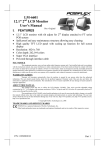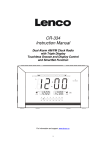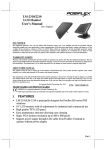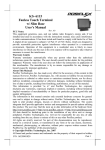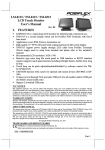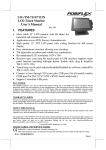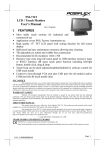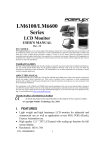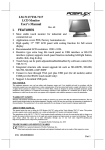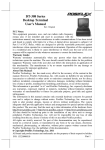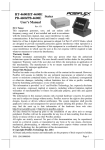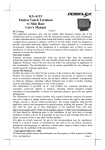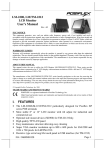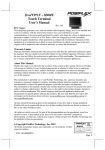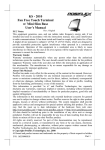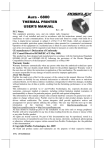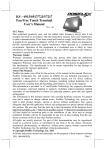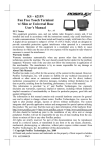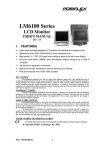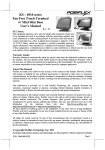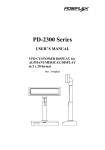Download User`s Manual
Transcript
LM-7112 / TM-7112 Series LCD / Touch Monitor User’s Manual Rev. B0 I. FEATURES • Most stable 12.1” LCD monitor with tilt adjust for industrial and commercial use • Application covers POS, POI (Kiosk), Factory Automation etc. • USB HUB function with 2 ports for optional side mount devices (BC300 or SD300) or USB KB or mouse • Spill proof and easy maintenance structure allowing easy cleaning • High quality TFT LCD panel with scaling up function for full screen display • Super VGA interface • Resistive type extra long life touch panel in RS232 (for TM-7112/ TM7112S) or USB interface (for TM-7112 / TM-7112S / TM-7112A) • Touch functions include left/right button, double click, drag & drop (for TM-7112 / TM-7112S / TM-7112A) • Touch beep can be pitch adjusted/enabled/disabled by software control (for TM-7112 / TM-7112S /TM-7112A) • LM-7112A/TM-7112A Support LED back light Panel FCC NOTICE This equipment generates, uses, and can radiate radio frequency energy and, if not installed and used in accordance with the instructions manual, may cause interference to radio communications. It has been tested and found to comply with limits for a Class A digital device pursuant to subpart J of Part 15 of FCC Rules, which are designed to provide reasonable protection against interference when operated in a commercial environment. Operation of this equipment in a residential area is likely to cause interference in which case the user at his own expense will be required to take whatever measures to correct the interference. WARRANTY LIMITS Warranty will terminate automatically when the machine is opened by any person other than the authorized technicians. The user should consult his/her dealer for the problem happened. Warranty voids if the user does not follow the instructions in application of this merchandise. The manufacturer is by no means responsible for any damage or hazard caused by improper application. ABOUT THIS MANUAL This manual assists the user to utilize the LCD Monitor LM-7112 series and the Touch Monitor TM-7112 series. These series provide adjustable robust construction for 12.1” LCD display with maximum resolution of 800 x 600 (or 1024 x 768 for LM-7112S / TM-7112S / TM-7112A). TM-7112 provides also a durable touch screen over the LCD panel. Both support a side mount option of SD-300 or BC-300. The manufacturer of the LM-7112 and TM-7112 series heartily apologizes to the user for reserving the right to change or to modify this manual without notice due to the rapid and constant progress and improvement on science and technology. The user may always obtain the most up to date information through any of our web sites: http://www.posiflex.com, http://www.posiflex.com.tw, http://www.posiflexusa.com. Copyright Posiflex Technology, Inc. 2010 TRADE MARKS AND SERVICE MARKS POSIFLEX is a registered trademark of Posiflex Technology, Inc.. Other brand and product names are trademarks and registered trademarks and service marks of their respective owners. P/N: 19660900030 Part 1 II. MODEL NUMBERS LM-7112: LM-7112S: LM-7112A: TM-7112: TM-7112S: TM-7112A: 12.1” 800 x 600 LCD Monitor on adjustable stand 12.1” 1024 x 768 LCD Monitor on adjustable stand 12.1” 1024 x 768 LCD Monitor on adjustable stand 12.1” 800 x 600 LCD Touch Monitor on adjustable stand 12.1” 1024 x 768 LCD Touch Monitor on adjustable stand 12.1” 1024 x 768 LCD Touch Monitor on adjustable stand III. MAJOR OPTIONS 1. Color choice between Black and Ivory 2. Side mount device BC-300 (bar code card reader) or SD-300 (MSR and/or optical fingerprint reader) 3. Interface choice between RS232 (for TM-7112/TM-7112S) and USB touch control (for TM-7112/TM-7112S/TM-7112A) IV. CARTON CONTENTS 1. 2. 3. 4. 5. 6. 7. LCD Monitor panel unit (Main unit assembled with Stand) Posiflex Product Information CDROM User’s Manual Power Adaptor & power cord VGA Cable USB Cable (for connection to host USB port) Touch Control Cable (for RS232 model of TM7112/TM-7112S only) 8. Preinstalled side mount device if ordered V. PARTS IDENTIFICATION A. FRONT VIEW Option Device SD-300 or BC-300 Display Screen + Touch Panel Power LED Power Switch OSD Increase Adjust OSD Engage/Disengage Button OSD Item Select OSD Decrease Adjust Part 2 B. RIGHT SIDE VIEW (Downlink) USB Ports C. REAR VIEW Option unit mounting screws Option kit cable holder Brightness adjust knob Tilt adjust release button (Uplink) USB Port RS232 Port VGA Port DC Jack D. POWER LED INDICATION • Yellow: standby • Blue: operating Part 3 VI. HARDWARE INSTALLATION A. Side Mount Upgrade Kit When a side-mount upgrade kit option SD-300 or BC-300 is ordered with the LM/TM-7112 series, this option is already installed in the delivery. To assemble a separately delivered kit to the monitor, please use the 2 attached screws with washer to fix the kit to right side of LCD panel from back as revealed in rear view. No matter the kit is BC-300 or SD-300 or whether the SD-300 kit itself contains MSR only, finger print sensor only or both options, the kit utilizes one USB cable. Connect it to one downlink USB port at right side of the base and insert it in the cable holder on back of LCD panel. B. Cable Connections 1. Connect the VGA cable that has both 3 x 5 D sub male ends to VGA port at base rear bottom and the VGA port of host system. Screw in the cable to connectors at both ends. 2. Connect the USB cable that has one flat 4 pin connector (USB type A) and one square 4 pin connector (USB type B) to (uplink) USB port at base rear bottom and the USB port of host system. 3. For RS232 touch control type of TM-7112/TM-7112S, connect the touch control cable that has one 9 pin D sub female end and one 10 pin RJ45 plug to RS232 port at base rear bottom and one COM port of host system. Make sure the plug clicks in. Screw fix the COM port end. This connection is not required for other models and therefore this cable will not be included for those models. 4. Connect USB device(s) like USB keyboard or USB mouse that would be more convenient for the user’s application to the (downlink) USB port(s). However please note that if the side mount kit is installed, there will be only one USB port left for this service. 5. Check the power adaptor against local power supply specifications. Connect the cable from the power adaptor to the DC jack at base rear bottom. Connect the power cable to the power adaptor and a clean power socket. Part 4 VII. DRIVER INSTALLATION A. INSTALLATION 1. RS232 touch Please find in the attached Posiflex product information CDROM under subdirectory \Drivers\TM_LM\RS232 for RS232 interface touch controller driver. Click SETUP.EXE or select “Peripheral Drivers & Utilities” --> “RS232 Touch Driver” in the Posiflex product information CD of version 3.0 or later to install the driver into system and a utility program for touch calibration. Please select “SmartSet Serial Controller” as the controller type during the installation process. Same approach applies for other operating system. If, for any reason, the user wants to remove the driver for the RS232 touch controller, please select “Monitor Mouse” in the program list for removal. 2. USB touch The USB interface touch controller operates as an USB mouse without need for any special driver in Windows. However, there is a program supported for its calibration and touch function manipulation. Please find it in the attached Posiflex product information CD-ROM under subdirectory \Drivers\TM_LM\USB or select “Peripheral Drivers & Utilities” --> “USB Touch Manager” in version 3.0 or later of Posiflex product information CD to install it. For Linux environment, please find the setup program for the suitable kernel in the same directory and install the required driver and calibration program as the setup program proceeds. B. SETUP/CALIBRATION 1. RS232 touch Once the RS232 touch controller driver is installed, the user can utilize it to calibrate the touch screen, define mouse button emulation modes, enable right button emulation or define the click sound’s tone and duration. Please go to “Control Panel” and select “Elo Touchscreen” to engage this utility. Most items in this utility should be easily understandable to average user. Followings are just some reminders on some items. Ÿ COM port – This port selection must match exactly the port touch control interface cable is connected to. Ÿ Align – This function engages 3 touch targets at left top, right bottom and right top consecutively for touch calibration. Part 5 Ÿ Click on touch – This selection of touch button disables the double click function of a touch and a left click will be registered at the point where a touch on the screen is made even if the touch is dragged to other spot before release. Ÿ Click on release – This selection of touch button disables the double click function of a touch and a left click will be registered at the point where a touch is released from the screen. Ÿ Drag – This selection of touch button disables the double click function of a touch and a left click contact signal will be sent to the host when a touch is made and a left click release signal will be there for touch release. Ÿ Drag, Double click – This selection of touch button allows the screen touch to simulate the complete left button of a mouse. Ÿ Double click size – This adjustment (10 to 100 pixels) is available only when double click function of the touch is enabled. The larger the size is, the easier it is to take 2 consecutive taps on the touch screen at nearly same spot as double click. Ÿ Show right-click sticky button – This function is only applicable in Win98 environment. When this box is checked, there will be a large icon on desktop simulating a mouse. After clicking the right button of the mouse in this icon, next touch on the screen will act like clicking the right button of a mouse. After this touch, it will automatically resume the left click function. 2. USB touch a. USB touch manager Once the USB control program is installed, the user can utilize it to calibrate the touch screen, define mouse button emulation parameters, enable right button emulation or define the click sound’s tone and duration. Please go to “Program Files” and select “Posiflex USB Touch Tools” and then select “Posiflex USB Touch Manager” within the tools to engage this utility. Most items in this utility should be easily understandable to average user. Followings are just some reminders on some items. Ÿ Calibrate – This button engages the “Posiflex USB Touch Calibrator”. Ÿ Edge Acceleration – This function engages the “Posiflex USB Touch Edge Acceleration Tool” and helps to find the hidden taskbar or thin scroll bar through touch. Ÿ Hide Cursor / Show Cursor – This button hides or shows the mouse cursor on screen display. Please never hide cursor before the touch is enabled and calibrated. Ÿ Buzz On – This check box together with the 2 list buttons below it Part 6 Ÿ Ÿ Ÿ Ÿ Ÿ Ÿ Ÿ Ÿ Ÿ determines the frequency and duration of the internal buzzer beep as response to touch on touch panel. Touch Point Dots – This list button selects the size of touch point on touch panel. A too small touch size makes the mouse cursor jumpy or even bouncing. A too large touch size results in unsatisfactory touch accuracy. Reset To Default – This button resets all touch parameters. Enable PIR – This check box is not applicable to the monitor. Please keep it unchecked. Enable Touch – This check box must be checked to have the touch panel working. Touch as Right Button Click – This check box defines each touch on touch panel as clicking the right button of mouse at that point. When it is unchecked, each touch will work as clicking the left button of mouse. (Ref. to the right hand version of mouse) Mouse Emulation/Click on Touch/Click on Release – Only one of the three radio buttons can be selected. The mouse emulation refers to the drag and drop function. OK – This button accepts all parameters set and closes the utility window. Apply – This button accepts all parameters set and remains in the utility window. Cancel – This button discards all changes to the parameters and closes the utility window. b. USB touch calibrator This program helps re-calibrating the touch position with the USB mouse emulation. Please touch the 3 calibration boxes and a confirmation box that appear sequentially. c. USB touch edge acceleration tool Helps to find the hidden taskbar or thin scroll bar through touch Ÿ Enable ... – Each check box determines whether or not to engage edge acceleration against which edge of screen. Ÿ Margin – This list button selects the range to engage edge acceleration toward the edge before the edge is reached. Ÿ Compensation – This list button selects the distance to advance the mouse toward edge from touch point. d. USB touch right button tool This tool differs slightly from the “Touch as Right Button Click” check box in the USB touch manager. When executed, there will be a small window of “One Shot Right Button” appearing on desktop. Any touch on the panel right after touching this small window will work like clicking the right button Part 7 of mouse at that point. However, the next touch will resume the left button of mouse unless the small window is touched again. Part 8 VIII. APPLICATION A. TILT ANGLE ADJUST Press down the tilt adjust release button as arrowed in the right picture and adjust the LCD panel tilt angle between 42.5° and 77.5° for best viewing effect in application and then release the button. The screen will be firmly held for operation. B. BRIGHTNESS ADJUST On lower left edge of back of the LCD panel there is a plastic wheel knob as circled in the picture above. Turning this knob up or down changes the brightness of screen display accordingly. C. APPLICATION LIMITATION With RS232 touch controller driver, certain display mode like full screen display of Windows DOS box should be avoided. The USB touch is not applicable for OS other than Windows as USB mouse is not supported in DOS environment and there is difficulty in engaging driver to convert the coordination system between the static panel and the dynamic mouse in Linux environment. D. SIDE MOUNT KIT In SD-300 mounted at right side of the monitor, there may be the MSR for reading a magnetic stripe card and/or the optical type finger print sensor. For magnetic stripe card reading, be sure to insert the card to the bottom with magnetic stripe facing the mark aside the slot. The movement of the card can be either inserting the card from the top surface then sliding the card down out of the slot, or sliding the card upward from the lower side of the slot till it reaches the top end as long as the card is a standard one. A non-standard card recorded without complete degaussing prior to recovery may accept only one direction in card reading. If the fingerprint sensor option is installed in the side mount kit, please find the most comfortable angle for the fingerprint taking operation in consideration of the LCD panel tilt angle and try to align the core of fingerprint in the sensing area. E. Power & OSD buttons The buttons at front of base are for the OSD (On Screen Display) control operations and LCD screen power control as in left picture and are explained below. Part 9 “OSD” button: To enter OSD setup menu, or to perform the function selected in OSD operation. “NEXT” button: To select next item of option functions. “” “” button: To increase setting. “” “” button: To decrease setting. “” “” button: To turn the monitor power ON/OFF. The monitor can be turned OFF only when there is video signal and can be turned ON only when there is video signal and after the “Turn Off Panel” message vanishes. The default status is set to ON when power is supplied unless manually turned OFF. Since this button controls only the display power but not the display controller neither the touch controller, please try disconnect the power cable or the VGA cable once unfortunately the screen display goes into a mess. Please also avoid touching the screen with the system still running though this power switch is turned off. F. OSD functions Press “OSD” button with a normal display on the screen to activate the OSD functions (On Screen Display adjustment). The OSD window will pop up on the screen. On top part of this window is a Posiflex logo with the OSD firmware version indicated to its lower right. Below this area is a row of icons for main OSD menu. Below the main menu is a group of icons for submenu that corresponds to one icon selected in the main menu. An analysis of the video signal on resolution and refresh rate will be displayed at the bottom. Applicable icons in the main menu and its subsequent menus are explained below. “MAIN MENU”: There are in total 5 icons in this menu: One of the 5 icons will be displayed in inverted color to indicate its relationship with the submenu below. Pressing “NEXT” button will shift the selected icon one by one from left to right and then wrap around to the most left. Press “OSD” button to enter the selected sub menu. If there is no button for OSD setting is pressed within a period of time (about 5 seconds to 1 minute as programmed) the OSD window will disappear with all the adjusted parameters saved. Explanations on items in sub menu are as below. “BRIGHTNESS / CONTRAST ADJUST SUBMENU”: There are 3 icons in this submenu: Press “OSD” button to select item or return to main menu. Press “NEXT” button to select among brightness, contrast and exit. “BRIGHTNESS ADJUST”: When this item is selected, there will be only the brightness icon with an adjustment indication bar under it between the main menu area and the video signal mode. Press “+” button to increase brightness. Press “-” to decrease. Press “OSD” button Part 10 to save the current setting and return to “Brightness/Contrast submenu”. “CONTRAST ADJUST”: When this item is selected, there will be only the contrast icon with an adjustment indication bar under it between the main menu area and the video signal mode. Press “+” button to increase contrast. Press “-” to decrease. Press “OSD” button to save the current setting and return to “Brightness/Contrast submenu”. “EXIT”: Return to “Main menu”. “COLOR ADJUST SUBMENU”: There are 4 icons in this submenu: Press “OSD” button to select item or return to main menu. Press “NEXT” button to select among auto color adjust, auto RGB reset, Color balance adjust and exit. “AUTO COLOR ADJUST”: Upon an “OSD” button press on this icon the monitor will perform an automatic color adjustment and exits the OSD window leaving 2 icons below at center of the screen. Press “NEXT” button to switch the selection. Press “OSD” button to make the choice. “ACCEPT”: Accept the adjustment setting. “REJECT”: Decline the adjustment setting and return to previous setting. “AUTO RGB RESET”: Upon an “OSD” button press on this icon the monitor will perform an automatic RGB reset and exits the OSD window leaving 2 icons below at center of the screen. Press “NEXT” button to switch the selection. Press “OSD” button to make the choice. “ACCEPT”: Accept the reset result. “REJECT”: Decline the reset and return to previous setting. “COLOR BALANCE ADJUST”: When this item is selected, there will be 7 icons in this item: between main menu area and the video signal mode. Press “OSD” button to select an item or return to color adjust submenu. Press “NEXT” button to select among separate color adjust, 4200K, 5000K, 6500K, 7500K, 9300K and exit. “SEPARATE COLOR ADJUST”: When this item is selected, there will be 3 adjustment indication bars between the main menu area and the video signal mode. Press “NEXT” button to select among the 3 colors Red, Green and Blue respectively. Press “+” button to intensify that color. Press “-” to reduce. Press “OSD” button to save the current setting and return to “Color balance adjust submenu”. “4200K”: Pressing “OSD” button on this icon will set the color balance to a color temperature of 4200 degrees Kelvin. Part 11 “5000K”: Pressing “OSD” button on this icon will set the color balance to a color temperature of 5000 degrees Kelvin. “6500K”: Pressing “OSD” button on this icon will set the color balance to a color temperature of 6500 degrees Kelvin. “7500K”: Pressing “OSD” button on this icon will set the color balance to a color temperature of 7500 degrees Kelvin. “9300K”: Pressing “OSD” button on this icon will set the color balance to a color temperature of 9300 degrees Kelvin. “EXIT”: Return to “Color adjust submenu”. “EXIT”: Return to “Main menu”. “GEOMETRY ADJUST SUBMENU”: There are 6 icons in this submenu: Press “OSD” button to select item or return to main menu. Press “NEXT” button to select among auto geometry adjust, horizontal size, phase, horizontal position, vertical position and exit. “AUTO GEOMETRY ADJUST”: Upon an “OSD” button press on this icon the monitor will perform an automatic geometry adjustment and exits the OSD window leaving 2 icons below at center of the screen. Press “NEXT” button to switch the selection. Press “OSD” button to make the choice. “ACCEPT”: Accept the adjustment setting. “REJECT”: Decline the adjustment setting and return to previous setting. “HORIZONTAL SIZE”: When this item is selected, there will be only the horizontal size icon with an adjustment indication bar under it between the main menu area and the video signal mode. Press “+” button to increase horizontal size. Press “-” to decrease. Press “OSD” button to save the current setting and return to “Geometry adjust submenu”. “PHASE”: When this item is selected, there will be only the phase adjust icon with an adjustment indication bar under it between the main menu area and the video signal mode. Press “+” or “-” button to adjust the pixel synchronization phase for best picture display. Press “OSD” button to save the current setting and return to “Geometry adjust submenu”. “HORIZONTAL POSITION”: When this item is selected, there will be only the horizontal position icon with an adjustment indication bar under it between the main menu area and the video signal mode. Press “+” or “-” button to shift the screen display to right or left. Press “OSD” button to save the current setting and return to “Geometry adjust submenu”. “VERTICAL POSITION”: When this item is selected, there will be only the vertical position icon with an adjustment indication bar Part 12 under it between the main menu area and the video signal mode. Press “+” button to shift up the screen display. Press “-” to shift down. Press “OSD” button to save the current setting and return to “Geometry adjust submenu”. “EXIT”: Return to “Main menu”. “TOOLS SUBMENU”: When this item is selected, there are 5 icons in this submenu: Press “OSD” button to select item or return to main menu. Press “NEXT” button to select among OSD submenu, reset to default, phase, smoothness / sharpness adjust, mode select and exit. “OSD SUBMENU”: When this item is selected, there are 4 icons in this submenu: Press “OSD” button to select item or return to main menu. Press “NEXT” button to select among OSD time, OSD horizontal position, OSD vertical position and exit. “OSD TIME”: When this item is selected, there will be only the OSD time icon with an adjustment indication bar under it between the main menu area and the video signal mode. Press “+” or “-” button to adjust the waiting time for OSD operation before OSD termination between 5 to 60 seconds. Default is 30 seconds. Press “OSD” button to save the current setting and return to “OSD submenu”. “OSD HORIZONTAL POSITION”: When this item is selected, there will be only the vertical position icon with an adjustment indication bar under it between the main menu area and the video signal mode. Press “+” button to shift OSD window right. Press “-” to shift left. Press “OSD” button to save the current setting and return to “OSD submenu”. “OSD VERTICAL POSITION”: When this item is selected, there will be only the vertical position icon with an adjustment indication bar under it between the main menu area and the video signal mode. Press “+” button to move OSD window downward. Press “-” to go upward. Press “OSD” button to save the current setting and return to “OSD submenu”. “EXIT”: Return to “Tools submenu”. “RESET TO DEFAULT”: Pressing “OSD” button on this icon will set all parameters back to the status when the monitor left factory. “SMOOTHNESS / SHARPNESS ADJUST”: When this item is selected, there will be only the smoothness / sharpness adjust icon with an adjustment indication bar under it between the main menu area and the video signal mode. Press “+” button to increase smoothness of display (decrease sharpness). Press “-” to go the other way. Press “OSD” button to save the current setting and return to “OSD submenu”. “MODE SELECT”: Pressing “OSD” button on this icon will Part 13 have no effect at all if the display mode is not one of the confusing modes. The confusing modes here mean 640 x 400 or 720 x 400 in display resolution as both mode have refresh rate of 70Hz, horizontal frequency of 37.9KHz and pixel frequency of 31.5MHz making it impossible for automatic select. These modes are not used in normal Windows display. “EXIT”: Return to “Main menu”. “EXIT”: Exit OSD setup with all adjustment saved. Part 14 IX. SUPPORTED DISPLAY MODES For video signals beyond the supported display modes, there will be a message “Out Of Range” on middle of screen. Maximum supported color depth is 18 bits or 262,144 colors. Supported display modes are as in the table: Display Resolution Refresh Rate (Hz) Horizontal Frequency (KHz) 640*400 70 31.5 60 31.5 640*480 72 37.9 75 37.5 720*400 70 31.5 56 35.1 60 37.9 800*600 72 48.1 75 46.9 60 48.4 1024*768 (Note) 70 56.5 75 60 Note: This mode applies to models marked with LM-7112S/LM-7112A or TM-7112S/TM-7112A only. 警告使用者 T31454 這是甲類的資訊產品,在居住的環 境中使用時,可能會造成射頻干 擾,在這種情況下,使用者會被要 求採取某些適當的對策。 Part 15















